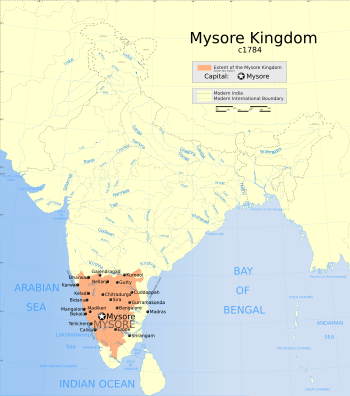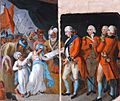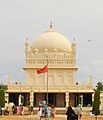Kingdom of Mysore facts for kids
Quick facts for kids
Kingdom of Mysore
Princely State of Mysore |
|||||||||
|---|---|---|---|---|---|---|---|---|---|
| 1399–1950 | |||||||||
|
Anthem: Kayou Sri Gowri
|
|||||||||

Kingdom of Mysore, 1784 AD (at its greatest extent)
|
|||||||||
| Status | Kingdom (Subordinate to Vijayanagara Empire until 1565). Princely state under the suzerainty of the British Crown after 1799 |
||||||||
| Capital | Mysore, Srirangapatna | ||||||||
| Common languages | Kannada | ||||||||
| Religion | Hinduism, Islam | ||||||||
| Government | Monarchy until 1799, Principality thereafter | ||||||||
| Maharaja | |||||||||
|
• 1399–1423 (first)
|
Yaduraya | ||||||||
|
• 1940–50 (last)
|
Jaya Chamaraja Wodeyar | ||||||||
| History | |||||||||
|
• Established
|
1399 | ||||||||
|
• Earliest records
|
1551 | ||||||||
|
• Disestablished
|
1950 | ||||||||
|
|||||||||
| Today part of | India | ||||||||
The Kingdom of Mysore was a kingdom in southern India, traditionally believed to have been founded in 1399 in the vicinity of the modern city of Mysore. The kingdom, which was ruled by the Wodeyar family, initially served as a vassal state of the Vijayanagara Empire. With the decline of the Vijayanagara Empire (c. 1565), the kingdom became independent.
The 17th century saw a steady expansion of its territory and during the rule of Narasaraja Wodeyar I and Chikka Devaraja Wodeyar, the kingdom annexed large expanses of what is now southern Karnataka and parts of Tamil Nadu to become a powerful state in the southern Deccan.
The kingdom reached the height of its economic and military power and dominion in the latter half of the 18th century under the de facto ruler Haider Ali and his son Tipu Sultan. During this time, it came into conflict with the Marathas, the Nizam of Hyderabad, the Kingdom of Travancore and the British, which culminated in the four Anglo-Mysore Wars.
Success in the first Anglo-Mysore war and a stalemate in the second was followed by defeat in the third and fourth. Following Tipu's death in the fourth war of 1799, large parts of his kingdom were annexed by the British. The British restored the Wodeyars to their throne by way of a subsidiary alliance and the diminished Mysore was transformed into a princely state. The Wodeyars continued to rule the state until Indian independence in 1947, when Mysore acceded to the Union of India.
The first iron-cased and metal-cylinder rocket artillery were developed by Tipu Sultan and his father Hyder Ali, in the 1780s. The Mysore rockets of this period were much more advanced than what the British had seen, chiefly because of the use of iron tubes for holding the propellant; this enabled higher thrust and longer range for the missile (up to 2 km (1 mi) range).
After Tipu's eventual defeat in the Fourth Anglo-Mysore War and the capture of the Mysore iron rockets, they were influential in British rocket development, inspiring the Congreve rocket, which was soon put into use in the Napoleonic Wars.
Even as a princely state, Mysore came to be counted among the more developed and urbanised regions of India. This period (1799–1947) also saw Mysore emerge as one of the important centres of art and culture in India. The Mysore kings were not only accomplished exponents of the fine arts and men of letters, they were enthusiastic patrons as well, and their legacies continue to influence music and art even today.
The vast majority of the people lived in villages and agriculture was their main occupation. The economy of the kingdom was based on agriculture. Grains, pulses, vegetables and flowers were cultivated. Commercial crops included sugarcane and cotton. The farming population consisted of landlords who cultivated the land by employing a number of landless labourers, usually paying them in grain.
Minor cultivators were also willing to hire themselves out as labourers if the need arose. It was due to the availability of these landless labourers that kings and landlords were able to execute major projects such as palaces, temples, mosques, anicuts (dams) and tanks. Because land was abundant and the population relatively sparse, no rent was charged on land ownership. Instead, landowners paid tax for cultivation, which amounted to up to one-half of all harvested produce.
This system changed under the British, when tax payments were made in cash, and were used for the maintenance of the army, police and other civil and public establishments. A portion of the tax was transferred to England as the "Indian tribute". Unhappy with the loss of their traditional revenue system and the problems they faced, peasants rose in rebellion in many parts of south India. After 1800, the Cornwallis land reforms came into effect.
Images for kids
-
Admiral Suffren meeting with ally Hyder Ali in 1783. J. B. Morret engraving, 1789
-
The flag of the Sultanate of Mysore at the entrance to the fort of Bangalore
-
A portrait of Tipu Sultan, made during the Third Anglo-Mysore War
-
Mural of the famous Battle of Pollilur in Tipu Sultan's summer palace in Srirangapatna
-
Lord Cornwallis hastily retreats after his unsuccessful siege of Srirangapatna (1792).
-
The Gopura (tower) of the Chamundeshwari Temple on the Chamundi Hills. The temple is dedicated to Mysore's patron deity.
-
The Jaganmohan Palace at Mysore – now an art gallery which is home to some of Raja Ravi Varma's masterpieces
-
Tipu Sultan's tomb at Srirangapatna
-
Lalitha Mahal at Mysore, now a five-star hotel, plays host to visiting dignitaries and VIPs.
See also
 In Spanish: Reino de Mysore para niños
In Spanish: Reino de Mysore para niños
























